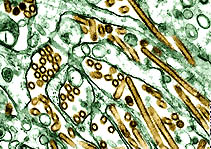“The H5N1 avian flu virus has mutated into a more dangerous form that could breed more effectively in mammals.”
– Cao Bao Van, Dir.,
Molecule Biology Department, Pasteur Institute, Vietnam

November 13, 2005 Washington, D. C. – The Centers for Disease Control and World Health Organization confirm that the 21st person has been infected with H5N1 bird flu in Thailand. The victim is an 18-month-old boy now in a Bangkok hospital. Medical authorities think the child contracted the deadly virus from three fighting cocks and a chicken kept at the family’s home in Bangkok. All those birds died soon after the child was hospitalized. So far, twenty-one people in Thailand have been infected by the H5N1 bird flu and 13 have died.
China reported on November 11, more H5N1 infections of poultry there that killed 300 chickens in Liaoning Province northeast of Beijing. There have been eight H5N1 outbreaks in china so far, but so far no human cases have been reported. The government has destroyed more than 2.5 million birds.
Kuwait and other Middle East countries have feared the spread of H5N1 into their territories by migrating birds. On Friday, November 11, the fear was realized when a flamingo found on a Kuwaiti beach was confirmed to have the H5N1 deadly strain of bird flu – the first known case in the Arab world. Mohammed al-Mihana of Kuwait’s Public Authority for Agriculture and Fisheries said the flamingo was imported and had been quarantined at the airport. The bird was destroyed. Kuwait is also fumigating farms and bird markets and are trying to monitor bird migratory routes for any signs of unusual avian deaths.
Currently, killing and incinerating H5N1-infected birds has been the first line of defense since 1997 when H5N1 first showed up in very ill Hong Kong patients. H5N1 had never been seen in people before then and several people died. That set off loud alarm bells in the world medical community and the Hong Kong government had more than a million chickens destroyed. But even though killing and incinerating infected birds has been standard operating procedure for nearly ten years, the H5N1 virus has continued to spread through migratory birds. Now the deadly virus is in Europe, spreading in October to Kazakstan, Russia, Romania, Croatia, Turkey and Greece. Between November 1st and 2nd in Russia, two more birds died from H5N1, bringing the total in that country to more than 4,000 bird deaths either from the H5N1 virus or slaughtering. It’s now estimated that more than 140 million birds in southeast Asia, China and Europe have been destroyed.
But what worries authorities is the virus’s persistence and increasing virulence, killing infected birds within 24 hours and killing some humans within five days who have picked up the virus from birds.
Not only is the latest bird flu virus more virulent in lab animal tests, it seems to be increasing its virulence among wild water birds. The World Health Organization reported in the spring of 2005 that at least 6,000 wild migratory geese at a nature reserve in central China, suddenly died from an H5N1 strain. W.H.O. described the large number of rapid deaths as “highly unusual and probably unprecedented.”
Vietnam Scientists Report H5N1 Has “Mutated into A More Dangerous Form”

Now scientists in Vietnam, where bird flu has killed 42 people, report their investigation shows the H5N1 avian flu virus has “mutated into a more dangerous form that could breed more effectively in mammals.” Cao Bao Van, Director of the Molecule Biology Department of the Pasteur Institute, which is Vietnam’s bird flu research center, reported this weekend that DNA analysis of 24 samples of the H5N1 virus taken from poultry and humans showed significant changes of the deadly virus’s surface proteins, known as “antigen variation.”
So far, the H5N1 virus mutations have not made it possible for the virus to spread in human sneezing and coughing. But such surface protein changes can lead to human-to-human transmission of the bird flu virus, similar to what happened in 1918 when the Spanish Flu killed more than 50 million people around the planet. Recently scientists announced that the 1918 virus also originated in birds and has similarities to the H5N1 now spreading through migratory birds. If that happens, the potential for a global pandemic that could kill millions of people is possible.
The American government’s preparation plan includes:
– Increased monitoring for H5N1 illness in humans.
– Stockpiling anti-virals and vaccines that might work against the H5N1 virus. Currently, there are some promising vaccines being tested on humans.
– Increasing public health’s ability to deal with overwhelming numbers of people going to hospital emergency rooms.
– And keeping the public aware about what the facts are.
To do this, the Bush Administration wants Congress to make $7.1 billion available to modernize flu vaccine production in the United States. The goal is to be able to inoculate every American all 300 million of us within 6 months of a pandemic’s eruption.
The problem is that could take years! The government’s goal is 2010. That’s only five years from now and the H5N1 virus is unpredictable, mutating and any day could change into one that can transmit human-to-human. China’s most famous virologist, Dr. Guan Yi, and his research team, have already sequenced the genetic code for more than 250 strains of H5N1. That means H5 bird flu virus has changed 250 times in less than a decade, becoming more virulent, not less.
H5N1 is now expected to spread through western Russia by spring 2006, where the density of population and farms is ten times higher than the Far East. So far, no humans in Russia have contracted the bird flu but Newsweek reported in its November 7th issue that there have been 138 human cases in southeast Asians, of which at least 69 people have died.
That 50% mortality rate in human victims is generally persisting beyond Thailand and Vietnam to Cambodia, Indonesia, and China. What no one knows is when? or if? the H5N1 virus that’s supposed to infect only birds, will mutate into a virus that can spread human-to-human through sneezing and coughing. That’s the nightmare medical people are worried about.
How Do People Get the H5N1 Virus?
By handling infected birds or bird feces during slaughter, butchering, removing feathers or preparing raw poultry for cooking. There is also some evidence that mammals such as pigs which were originally thought to be resistant to avian flu, have also become infected with the H5N1 virus from birds and subsequently might infect human pig handlers through contact. There are 15 different subtypes of H5 avian influenza that spreads among birds. But H5N1 and H7 are the only avian flu virus strains that kill so effectively.
What Are the Bird Flu Symptoms in Humans?
High fever, body aches, nausea, vomiting, diarrhea, that lead to hepatitis, kidney failure and an abnormal deficiency in all blood cells: red, white, and platelets. That means that H5N1 infection affects more body organs and systems than normal flu and H5N1 kills directly and rapidly while other flu deaths are often related to secondary infections caused by bacteria.
Can World Medical Community Stop A Pandemic?
Recently I talked about the pandemic threat with computer modelers who are studying how to contain the H5N1 avian virus as soon as there is any evidence of human-to-human transmission anywhere in the world. See: 102605 Earthfiles. One model shows that if all the families in an infected area quarantined themselves, and as many people as possible are treated for ten days with an antiviral medicine, such as Tamiflu, and H5N1 vaccines – an eruption of H5N1 among people might be contained. Progress is being made in American and other laboratories to produce an H5N1 vaccine based on the virus that has killed humans so far. The problem is that a mutation of H5N1 into human transmission could have surface proteins so different that vaccines might have limited effectiveness. But all medical authorities agree that an H5N1 vaccine must be developed and be ready to help slow down a potential pandemic.
If antivirals such as Tamiflu and Flu Mist are used prophylactively that means at the very first sign of fever, sore throat and body aches or as soon as a family member or work colleague becomes ill the antiviral can be 86% effective in slowing down viral spread in the human body. Tamiflu has even stopped some H5N1 strains in lab tests. Now the problem is hoarding. The American sales of Tamiflu have quadrupled the past few months, provoking the Swiss pharmaceutical, Roche, who makes Tamiflu to temporarily suspend shipments to the United States. Roche needs supplies for other countries. So now there is a plan for Roche to build a Tamiflu anti-viral production plant in the United States specifically to cope with an impending pandemic.
More Information:
For more about the H5N1 avian flu threat, please see other Earthfiles reports below in Earthfiles Archives:
- 10/26/2005 — Updated – H5N1 Bird Flu – The Next Pandemic?
- 07/22/2005 — H5N1 Bird Flu Virus Kills Three Indonesians
- 06/21/2005 — Vietnamese Doctor Studying H5N1 Bird Flu Falls Victim to Virus
- 06/03/2005 — West Nile and Bird Flu: Two Increasingly Dangerous Viruses
- 03/12/2005 — Could Avian Flu H5N1 Cause the Next Pandemic?
- 01/29/2004 — Unprecedented Outbreak of Avian Flu Has Killed Ten People in Asia
- 01/13/2004 — Updated: SARS and Bird Flu Back in Asia
- 12/16/2003 — Colorado Doctor Suspects Fujian Flu Has Hit Elderly Hard
- 01/18/2003 — Can the United States Cope with Bioterrorism Attacks?
Websites:
World Health Organization (W. H. O.): http://www.who.int/en/ Centers for Disease Control (CDC): http://www.cdc.gov/
University of Minnesota Pandemic Flu: http://www.cidrap.umn.edu/cidrap/content/influenza/panflu/index.html
Nature, May 2005, Bird Flu and Java Pigs: http://www.nature.com/nature/journal/v435/n7041/full/435390a.html
© 1998 - 2025 by Linda Moulton Howe.
All Rights Reserved.

